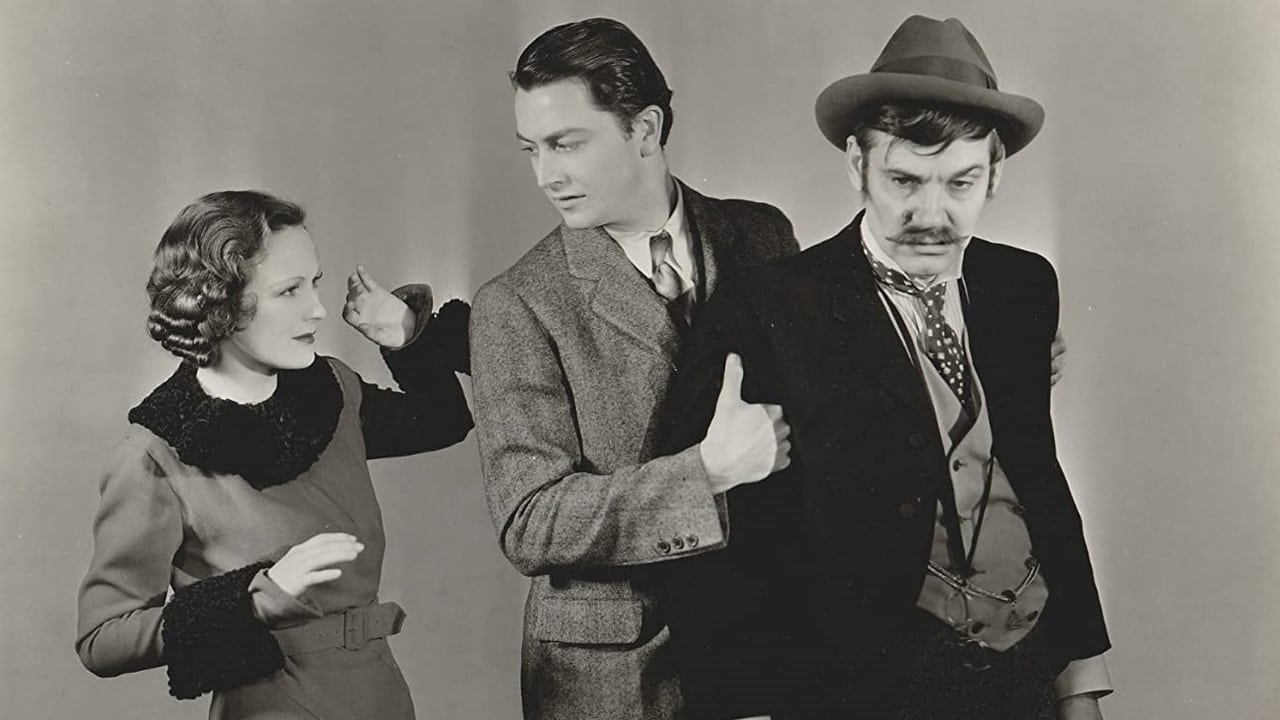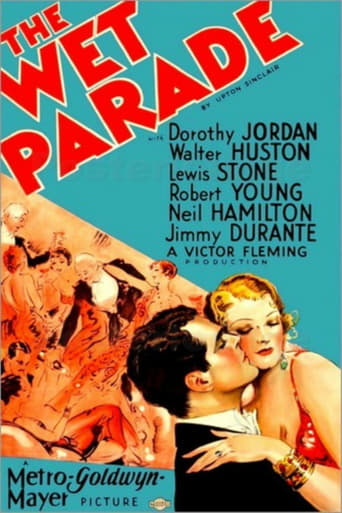

Far from Perfect, Far from Terrible
... View MoreIt's not great by any means, but it's a pretty good movie that didn't leave me filled with regret for investing time in it.
... View MoreIn truth, there is barely enough story here to make a film.
... View MoreIt is an exhilarating, distressing, funny and profound film, with one of the more memorable film scores in years,
... View MoreWet Parade (1932)A heavy social message movie but really well made, with some touching, in fact moving scenes. There is the first layer of drinking and the damage heavy drinking does (with some dramatic examples!). Then there is a political level, with electioneering and a kind of lobbying by the characters—and the movie—regarding drinking. The year it begins is 1916, more or less, and it's the cusp of the beginning of Prohibition, just a year before the U.S. enters WWI. (The war is a side issue—one character wisely says, "War has no good side.") The acting is quite realistic—this is a truly serious and large drama—and so the events take on poignant significance. Even if it might, sometimes, seem to preach (barely), it always puts it in human terms, and human costs."I never did take it up," says one main character, to explain his not drinking. It makes it seem like a drug ("I never did take up pot") and that's really the underlying attitude on both sides. Of course, there are lots of scenes of drunks and parties leading to good old drunkenness. One of the reasons for voting for Prohibitions is shown as economic—50 million bushels of wheat and rye were going to making drink, and in war time this was wrong.Remember that the movie was made in 1932 just as Prohibition was being repealed. I don't think it was simply a reminder to the audience of the history of the whole 14 year experiment in teetotaling. Progressive (Democratic) President Wilson did not approve the idea, but the states went ahead and ratified the amendment (not including some notable hold outs like Kentucky, home of great Bourbon). So, as a movie, there is a lot going on. Before the first hour is up we have one plot transform into another and then yet another. In a way it's quite remarkable. Director Victor Fleming is seven years away from his glory year (1939) and yet is showing a sustained intelligence and narrative savvy. And the camera keeps moving with engaging fluidity, the light varies greatly from night to day to night, and the editing is fast and intelligent. This is, technically, a superb movie.Now you might object to a certain level of moralizing—the drinkers are often cads or losers—but there is enough complexity of message to make this work overall. There is a sense that everyone (nearly) admits that Prohibition is a hopeless, and maybe senseless cause. As the plot moves toward its dramatic mobster climax, it feels more about pure crime than a moral issue, which got lost along the way.But that's perhaps what happened to the country, too, back in the long dry years of the 1920s. Which were not so dry after all, for many. Hypocrisy and irony abound. A truly interesting movie.
... View MoreIf I had one piece of advice for people wanting to try out films of the 1930s, it would be to check out any movie with Walter Huston in it. From Gabriel Over the White House to Kongo to The Beast of the City and more, the man was in some of the weirdest and most interesting films of the period. Here we have a film about the dangers of alcohol, made a year before prohibition ended. The film seems to be both anti-alcohol and anti-prohibition, which makes for some fascinating think-work about what the movie is really trying to advocate.The film starts with Lewis Stone's Colonel Sanders-looking Southern patriarch, whose daughter (Dorothy Jordan) is trying to get him to quit drinking. After a short while we move North to a fresh-faced Robert Young and his lush of a father Walter Huston. The two stories eventually intersect as Young falls in love with the daughter. Prohibition passes which leads to a tragedy for Young, who decides to become a treasury agent and is partnered with Jimmy Durante (!). From here the movie hits a bit of a lull as we get a fairly typical T-man story until the final minutes, which are exciting.The film offers some great moments such as the haunting image of Lewis Stone's final fate or the powerful scene where Walter Huston's wife confronts him about his bootleg liquor. The cast is excellent. The performances are melodramatic but in the best way. In addition to the stars already mentioned, we also have Neil Hamilton, Myrna Loy, and Wallace Ford. Not a bad lineup.As an entertainment piece, I think it's solid. But it has added value as a historical curio, allowing modern audiences to get perspective on the thoughts and feelings at the time regarding an important period in our history.
... View MoreThis Hollywood production takes a staunch (if peculiar) anti-alcohol, pro-Prohibition stance. It condemns the exaggeratedly tragic effects of alcohol consumption, as lives are torn apart by the mere existence of the Demon Drink. The film was released while Prohibition was still law, and it preached its Dry message directly at the 1932 audience.In a sense, THE WET PARADE (1932) does for alcohol what TELL YOUR CHILDREN (1936) does for marijuana. What sets this film apart is its compelling story and excellent cast.The film chronicles the rise of Prohibition out of World War I and the effects of its enforcement. It's an interesting take on the subject, showing the political and moral motivations behind the Dry movement, the last-minute hoarding of booze before the Eighteenth Amendment went into effect, the rise of speakeasies and bootlegging, and the government crackdown on liquor. The government men are portrayed like secret agents in enemy territory, infiltrating speakeasies undercover and gathering evidence before a raid. Saving the public from themselves.The movie even touches upon some of the negative consequences of Prohibition (poisonous bootleg liquor, organized crime, etc.), placing the blame not on the law, but the insatiable appetite for alcohol among deviant Americans.The cast assembled for this Prohibition epic is impressive. The leads are second-rate (Robert Young and Dorothy Jordan), but they are joined by some A-list supporting actors like Lewis Stone, Walter Huston, Wallace Ford, Jimmy Durante, John Miljan, Neil Hamilton, and even Myrna Loy.In hindsight, decades after the repeal of Prohibition in the U.S., it seems the filmmakers may have been a bit misguided in their didacticism, although, to be fair, the movie is based on a book. And the film was only discouraging activities which were illegal at the time.Still, the movie's crusading stance goes a little over-the-top. There's one scene near the end where John Miljan speaks right into the camera, directing his anti-booze rant at the viewers in the theatre. A noble gesture by MGM, supporting law and order, but it's a bit silly nowadays.
... View MoreTHE WET PARADE is the sort of old fashioned film that looked old and out of date even when it came out in 1932. In so many ways, this film is a carryover from the early silent anti-drinking melodramas of the first decade of the twentieth century--complete with ridiculously one-dimensional characters and a very heavy-handed message. In fact, the message is so heavy-handed that I seriously doubt if the anti-alcohol message had much effect on audiences--other than to elicit laughter! This is all very sad because very few films have ever addressed the impact of alcohol on its many victims (most of which aren't even the drinkers themselves)--too bad this was handled so poorly.Why do I say it was handled poorly? Well, many of the drunks portrayed in the film are totally one-dimensional and the actors overact so much as they portray them. This was pretty apparent with Lewis Stone's character, but compared to the ridiculous guy played by Walter Huston, he was downright subtle. As for Huston, he seemed more like a Tourette's sufferer than anything else, as he REPEATEDLY twirled his handlebar mustache and grunted (some actual symptoms of the disorder--seriously). However, most in the audience today may not recognize him, but this character acts almost exactly like those from melodramas of 30 years earlier--widely exaggerating EVERYTHING and chewing the scenery! In many ways, he seemed like a drunk version of Snidely Whiplash! Now when it comes to the impact on those around these ridiculous drunks, the film did a much better job. The co-dependent family members and enabling friends were excellent touches--but still weren't enough to make up for the awful characters played by Stone and Huston.Other than these silly drunks, the film also chronicled the history of the prohibition movement--and this was mildly interesting from a historical point of view. What I learned from the movie is that what really helped this anti-liquor crusade was WWI and moves to stop the production of intoxicants in order to feed our troops and starving Europeans. An interesting tidbit amongst the "sledgehammer symbolism" throughout this entire film.If anyone knows of a movie to SERIOUSLY address alcoholism from this era, let me know--as for THE WET PARADE, it's practically cartoon-like in its generalizations and bad characterizations. It's good for a laugh and maybe a brief history lesson buried within, but that's about all.FYI--The director of this film, Victor Fleming, was himself an extremely heavy drinker according to several biographies I've read (including CLARA BOW: RUNNING WILD). And, ironically, if you read the biography for Huston on IMDb, he apparently was the master of ceremonies at a brewery party the night Prohibition expired!!
... View More